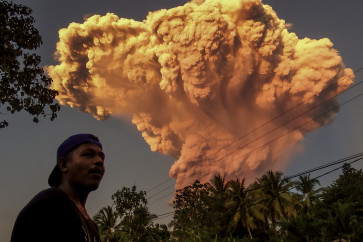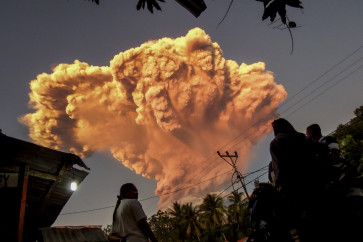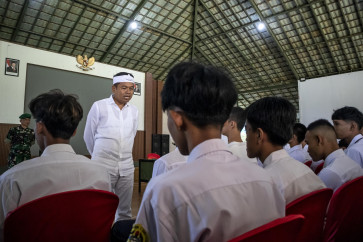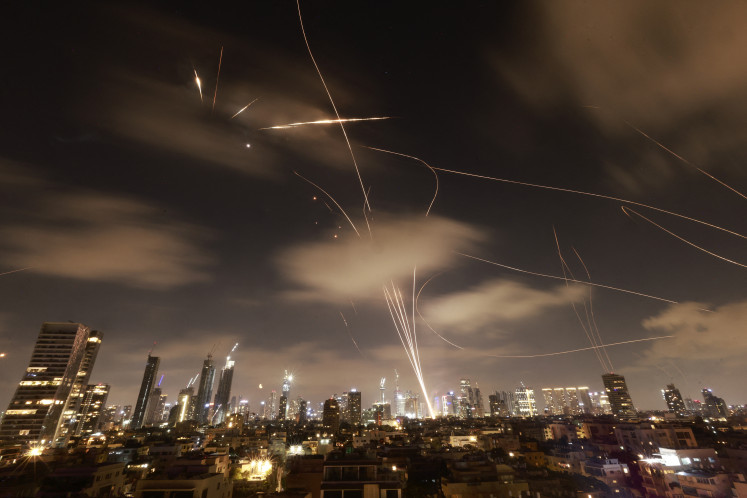Popular Reads
Top Results
Can't find what you're looking for?
View all search resultsPopular Reads
Top Results
Can't find what you're looking for?
View all search resultsRomualdo Locatelli: His artistic voyage, from Rome to Bali
A new book on Italian artist Romualdo Locatelli reveals new traces of his artistic whereabouts
Change text size
Gift Premium Articles
to Anyone

A new book on Italian artist Romualdo Locatelli reveals new traces of his artistic whereabouts.
Italian artist Romualdo Locatelli’s niece, Daniela Locatelli, who presides over the Locatelli Art Association, presented a new book, titled Romualdo Locatelli, An Artistic Voyage from Rome the Eternal City to Bali, the Island of the Gods, on June 22 before a select group of invitees at the National Gallery of Indonesia in Jakarta.
Italian Ambassador to Indonesia Vittorio Sandalli, who attended the launch, noted that the book marked the 80th anniversary of the artist’s first exhibition in Java and the 70th anniversary of diplomatic relations between Indonesia and Italy.
Written and edited by Vitorio Sgarbi and published by the production house Skira, the book comes as a 228-page paperback.
Daniela, who acted as the project’s initiator and coordinator, said she had visited Indonesia several times to meet people who had known and befriended her uncle.
“I started researching my uncle in 1972 and came back in 1998, and finally in 2019,” she says.
The book is a monograph that follows a standard print format on standard paper, where its importance lay not so much on the pictorial representation of the artwork but rather in the detailed written descriptions of some artwork and of the artist’s encounters during his voyage in the Indies and beyond.
The book is a complete biographical account that chronicles his entire artistic life and oeuvre — from the early years in Italy, where his first brushstrokes were guided by family traditions of the Locatelli family workshop, to the coveted stages of Milan and the Capital, interspersed with his first artistic journeys in Sardinia, Sicily, Maremma, Africa and the last years of his life in the East, including the Indies and the Philippines, where he was last seen going into the woods, and has since disappeared.
Although the prints in the book could have been better to do justice to the brilliance of the artist, the detailed descriptions and narratives on his life and oeuvre constitute an enriching source for collectors in Indonesia who adore his works.
“He is a genius,” said Asiong, one of his many collectors, who attended the launch, “No one can paint like him”.
Romualdo then must have been a real talent that at barely 20 years of age had already produced a work that earned him a lot of praise.

The painting Suffering is mentioned as an “original powerful work, an extreme example of a timeless naturalism”, wrote art critic Conile Dartis, noting the different shades of white — the cold white of the wall against the living white of the plaster. Such standout of white was prominent in most of Locatelli’s future works, which were marked by rapid brushwork and a color palette of earth tones.
As virtuous as his works in Europe were, they mostly appeared in an almost dark mode, quite different from his oeuvre in the tropics where he found a lightness of life in the sun that shone on the exotic beings, the green landscapes and the uplifting looks of the people with their all-time smiles.
If Java reminded him of a paradise, in Bali the artist was fascinated by the dance rhythms of nude seductive women dancers that deepened his innate sensuality, evoking in him a sense of godly beings.
His model Tigah, for instance, inspired him greatly and led him to create Tigah, The Balinese Goddess. “Just look at her slender arms and long legs, her delicate hands and feet, her body so glamorous, her expressive eyes, small nose, full mouth, her hair so thick and glossy — she is like a Goddess. Her golden brown skin, so tanned by the sun, looks like velvet. I would call her very beautiful,” he had said.
Locatelli was born in 1905 in Bergamo, amid the alpine region in northern Italy. He was born into a family of artists and craftsmen, including the art of frescoes. At the age of 20, he already won the silver medal from the ministry of national education.
After several successes in the local scene, his restless spirit working locally, Locatelli needed to get out. He visit Africa twice, then in 1939 together with his wife Erminia he boarded a cruise ship to the East.
In 1939, he arrived in Batavia. Initially, he settled in Bandung where he stayed with De Jongs, a representative of the Dutch Indies government whom he happened to have met while in Rome.
Soon, however, he set up a studio in Batavia and began traveling in Java, ultimately reaching Bali where exotic landscapes and its female dancers were compelling inspiration.
It was in Bali, writes Sgarbi, that the artist underwent an aesthetic rebirth and produced masterpieces on which his reputation ultimately rests. When they danced, the women of Bali aroused the painter’s passion and sensual character, as clearly attested by all the canvases of this period.
As art critic Amir Sidharta notes in his brief essay on Locatelli’s brief life in the Indies, Locatelli’s shows received positive reviews.
Amir, who researched Locatelli’s impact, critically noted that his various exhibitions held in Batavia, Bandung and Surabaya in East Java garnered positive media reviews. His paintings were readily collected, including by Indonesia’s first president Sukarno.
Other brief essays included in the book were written by Susanna Misiano who referred to the Roman years; Maria Cristina Rodechini, director of the Fondazione Accademia Carrara in Bergamo, Italy; Philippe Augier of Museum Pasifika in Bali; and Didier Hamel of Duta Fine Arts Gallery, who have known and befriended the artist.
It may be said that it is particularly Locatelli’s works in the Indies that found popular acclaim. But some may wonder why on the list of solo exhibitions, there is not a single Italian museum to have staged a special exhibition for Romualdo Locatelli.

— Photos courtesy by Associazione Culturale Amici dei Locatelli Figli d’Arte









